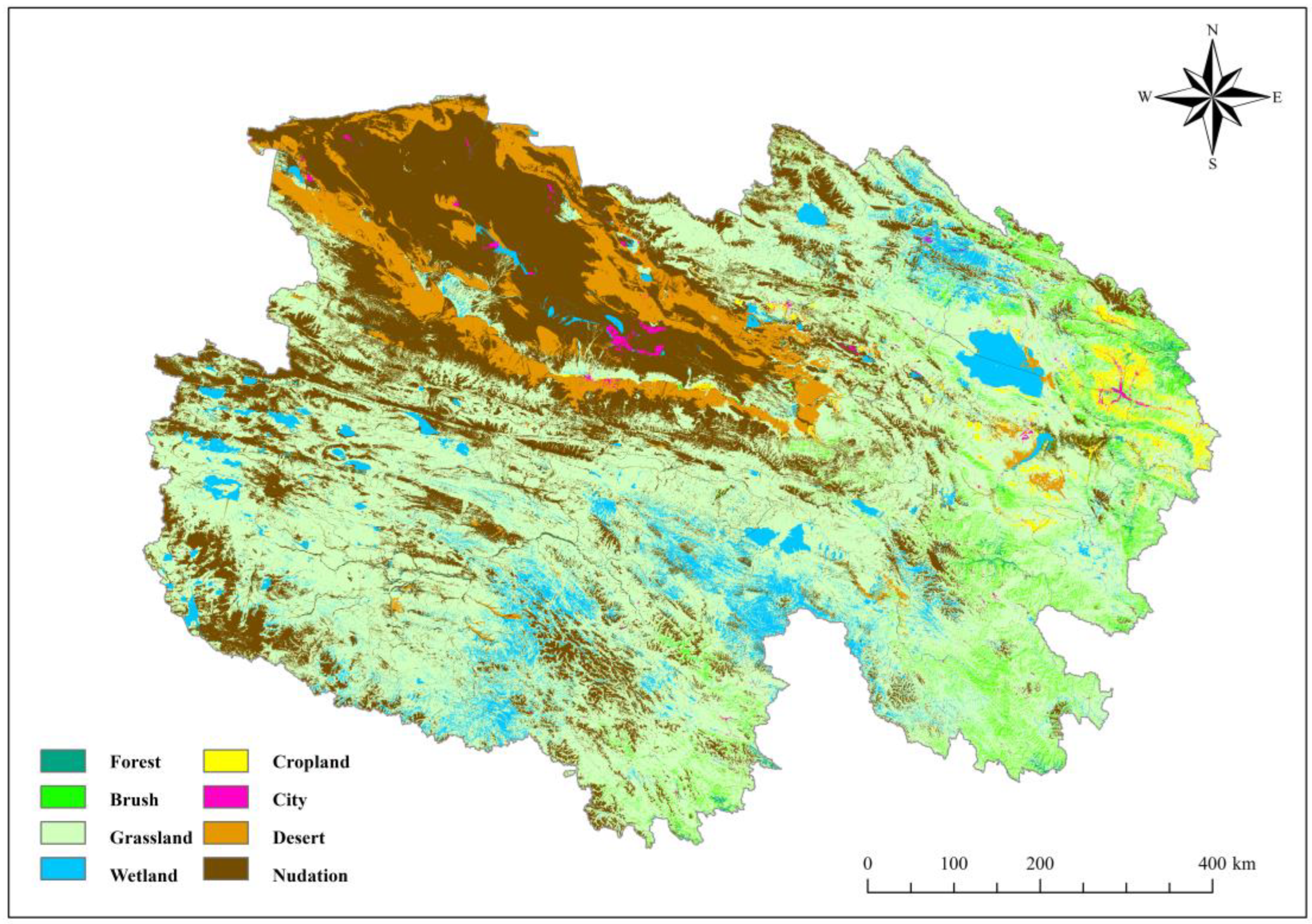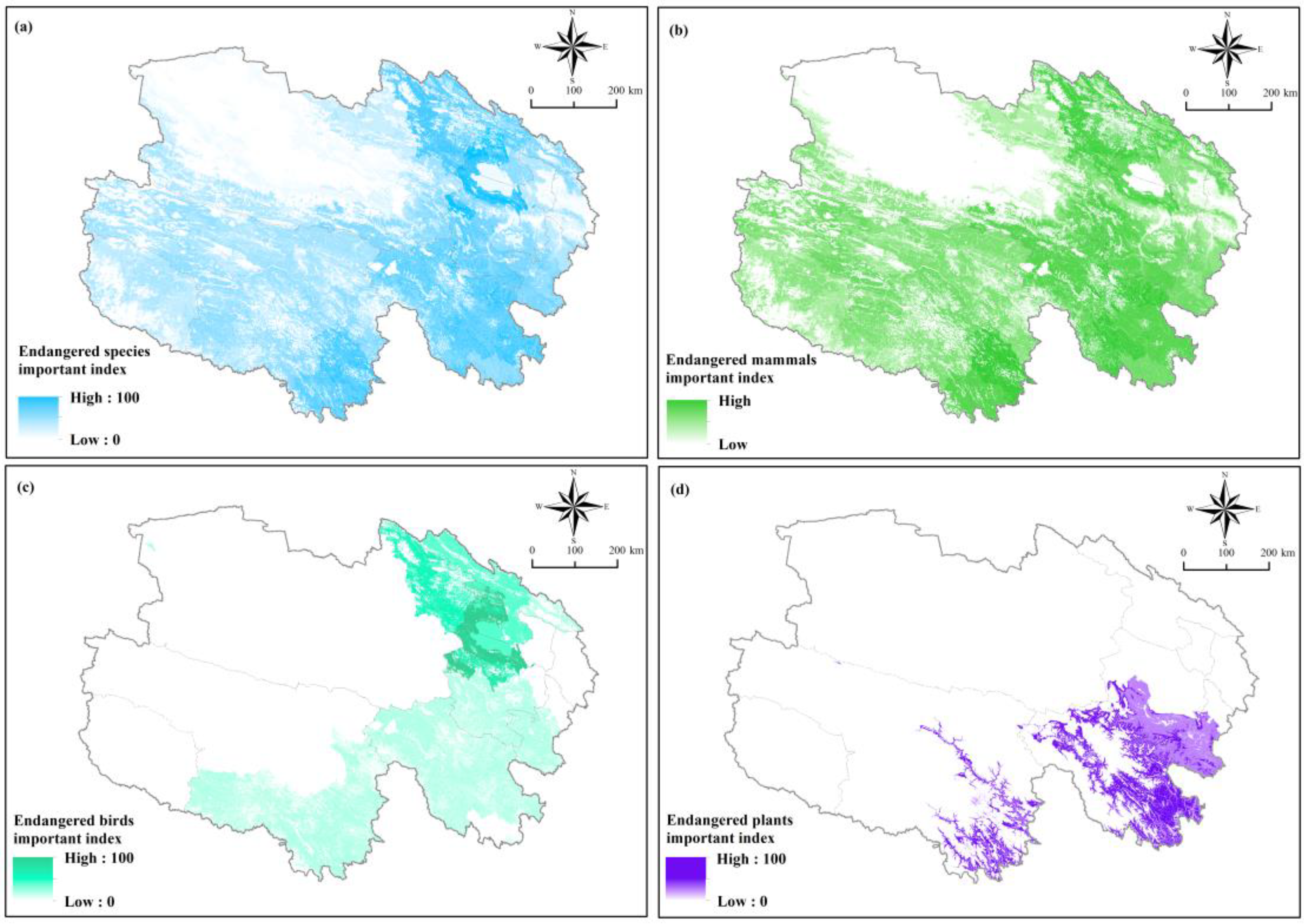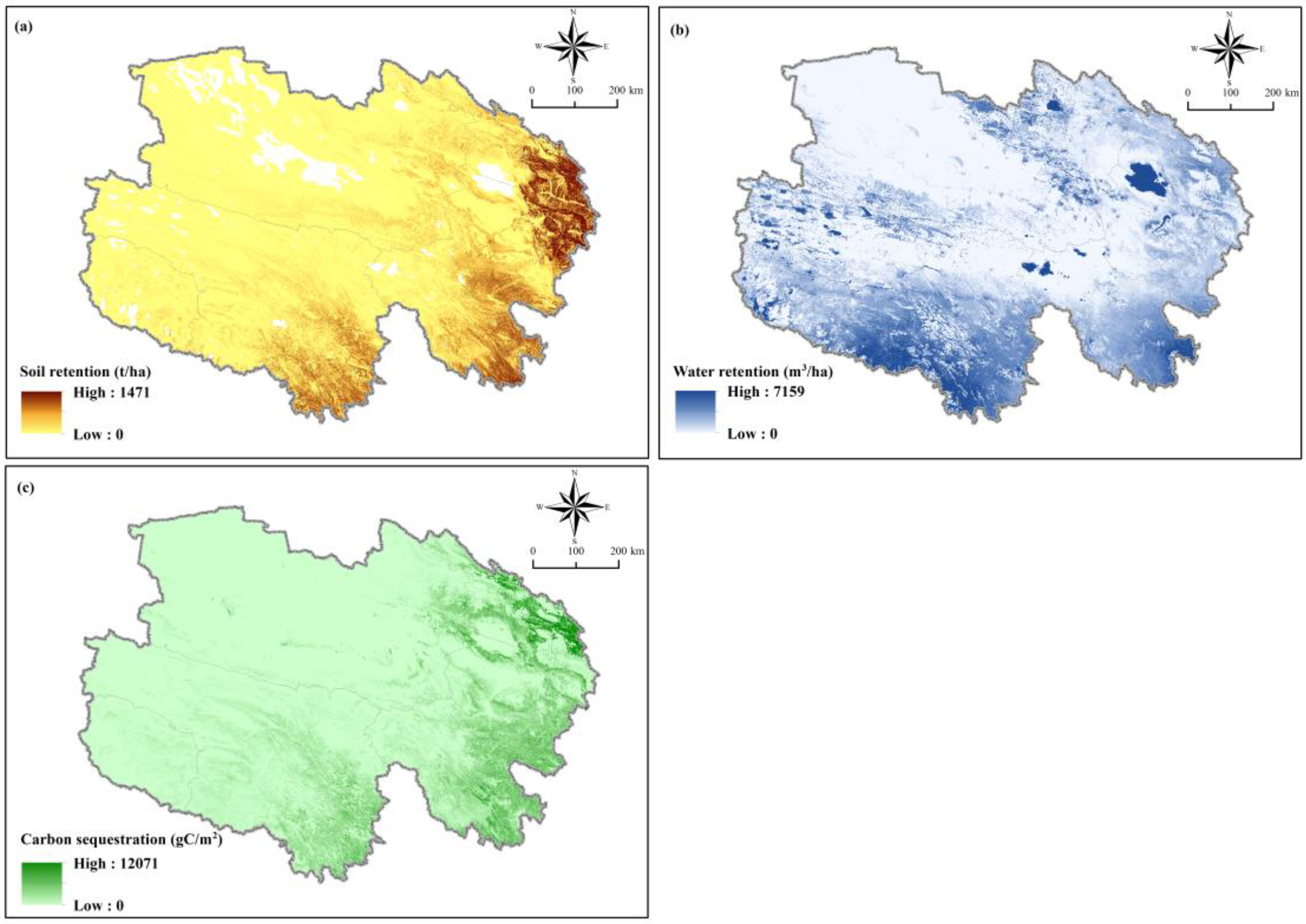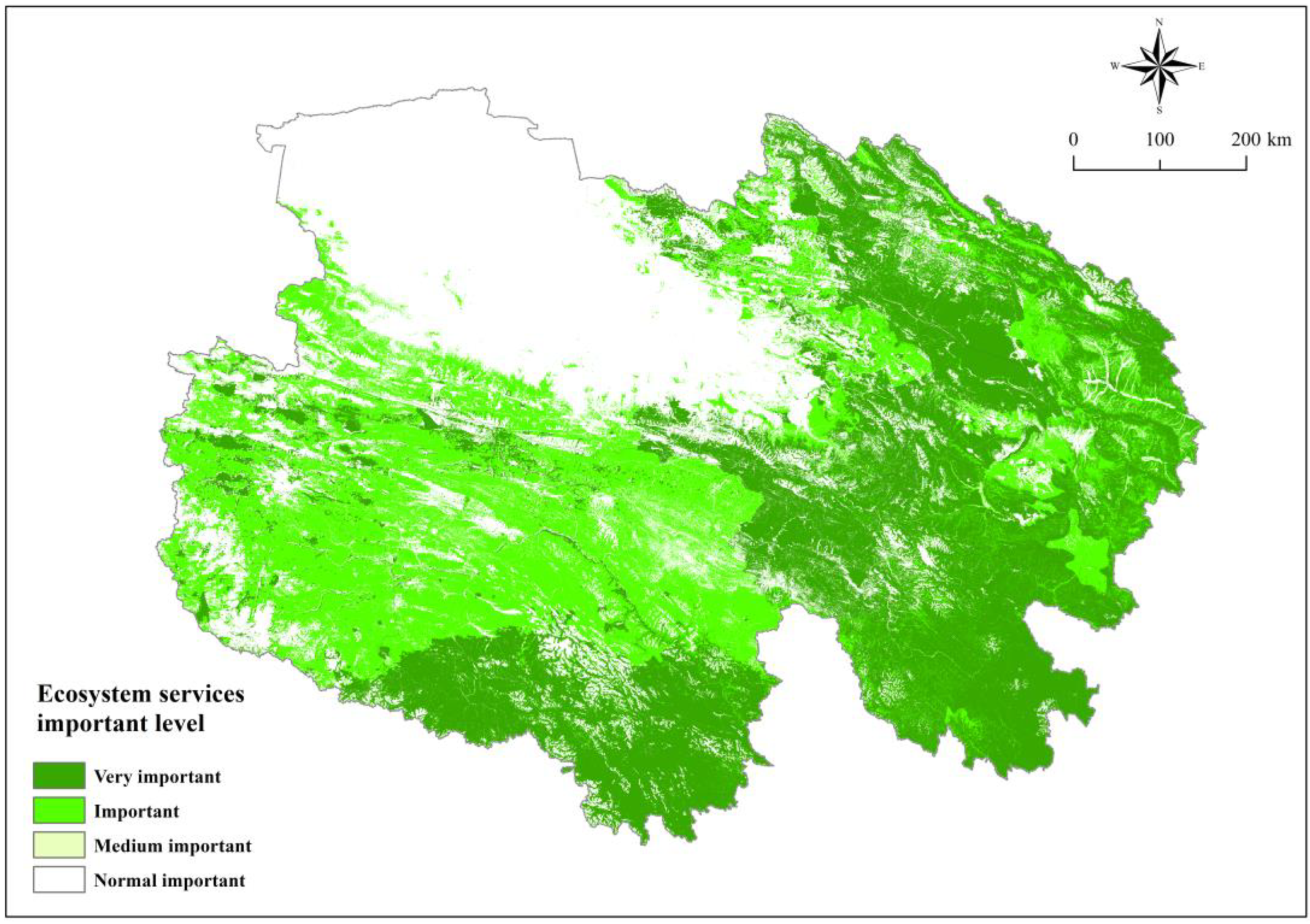Defining Important Areas for Ecosystem Conservation in Qinghai Province under the Policy of Ecological Red Line
Abstract
:1. Introduction
2. Materials and Methods
2.1. Research Area
2.2. Data Sources
2.3. Data Analysis
Ecosystem Service Function Calculations
3. Results
3.1. Classification Characteristics of Ecosystem Patterns
3.2. Evaluation of Ecosystem Service Functions
3.3. Selection of Important Areas in Qinghai Province
4. Discussion
4.1. Biodiversity Protection
4.2. Strengthen the Protection and Natural Recovery of Ecology Function Areas
4.3. Strengthening of Red Line Monitoring and Evaluation
5. Conclusions
Author Contributions
Funding
Institutional Review Board Statement
Informed Consent Statement
Data Availability Statement
Acknowledgments
Conflicts of Interest
References
- Abdulkarim, B.; Yacob, M.R.; Abdullah, A.M.; Radam, A. Farmers’ perceptions and attitudes toward forest watershed conservation of the North Selangor Peat Swamp Forest. J. Sustain. For. 2017, 36, 309–323. [Google Scholar] [CrossRef]
- Jiang, W.; Lü, Y.; Liu, Y.; Gao, W. Ecosystem service value of the Qinghai-Tibet Plateau significantly increased during 25 years. Ecosyst. Serv. 2020, 44, 101146. [Google Scholar] [CrossRef]
- Zhang, J.; Hull, V.; Huang, J.; Yang, W.; Zhou, S.; Xu, W.; Huang, Y.; Ouyang, Z.; Zhang, H.; Liu, J. Natural recovery and restoration in giant panda habitat after the Wenchuan earthquake. For. Ecol. Manag. 2014, 319, 1–9. [Google Scholar] [CrossRef]
- Miao, C.; Duan, Q.; Sun, Q.; Lei, X.; Li, H. Non-uniform changes in different categories of precipitation intensity across China and the associated large-scale circulations. Environ. Res. Lett. 2019, 14, 025004. [Google Scholar] [CrossRef]
- Walsh-Wilkinson, E.; Beaumont, C.; Drolet, M.; Roy, È.; Houillier, C.L.; Beaudoin, J.; Arsenault, M.; Couet, J. Effects of the loss of estrogen on the heart’s hypertrophic response to chronic left ventricle volume overload in rats. PeerJ 2019, 7, e7924. [Google Scholar] [CrossRef] [PubMed] [Green Version]
- Sun, Q.; Miao, C.; Hanel, M.; Borthwick, A.G.L.; Duan, Q.; Ji, D.; Li, H. Global heat stress on health, wildfires, and agricultural crops under different levels of climate warming. Environ. Int. 2019, 128, 125–136. [Google Scholar] [CrossRef]
- Gao, Y.; Zhou, F.; Ciais, P.; Miao, C.; Yang, T.; Jia, Y.; Zhou, X.; Klaus, B.; Yang, T.; Yu, G. Human activities aggravate nitrogen-deposition pollution to inland water over China. Natl. Sci. Rev. 2020, 7, 430–440. [Google Scholar] [CrossRef] [Green Version]
- Bai, Y.; Jiang, B.; Wang, M.; Li, H.; Alatalo, J.M.; Huang, S. New ecological redline policy (ERP) to secure ecosystem services in China. Land Use Policy 2016, 55, 348–351. [Google Scholar] [CrossRef] [Green Version]
- Yin, M.; Gao, X.; Tenuta, M.; Kuang, W.; Gui, D.; Zeng, F. Manure application increased denitrifying gene abundance in a drip-irrigated cotton field. PeerJ 2019, 7, e7894. [Google Scholar] [CrossRef] [PubMed]
- Birundu, A.O.; Suzuki, Y.; Gotou, J.; Matsumoto, M. Analysis of the role of forest, biomass policy legislation and other factors that may affect the future of Kenya’s forests: Use of Japanese forestry as a model. J. Sustain. For. 2017, 36, 90–105. [Google Scholar] [CrossRef]
- Dao, T.H.H.; Hölscher, D. Fujian cypress and two other threatened tree species in three conservation zones of a nature reserve in north-western Vietnam. For. Ecosyst. 2017, 4, 1–11. [Google Scholar] [CrossRef] [Green Version]
- Desnoues, E.; de Carvalho, J.F.; Zohner, C.M.; Crowther, T.W. The relative roles of local climate adaptation and phylogeny in determining leaf-out timing of temperate tree species. For. Ecosyst. 2017, 4, 1–7. [Google Scholar] [CrossRef] [Green Version]
- Cao, S.; Lu, C.; Yue, H. Optimal tree canopy cover during ecological restoration: A case study of possible ecological thresholds in Changting, China. BioScience 2017, 67, 221–232. [Google Scholar] [CrossRef] [Green Version]
- Cao, S.; Zhang, J. Political risks arising from the impacts of large-scale afforestation on water resources of the Tibetan Plateau. Gondwana Res. 2015, 28, 898–903. [Google Scholar] [CrossRef]
- Amiri, N.; Emadian, S.F.; Fallah, A.; Adeli, K.; Amirnejad, H. Estimation of conservation value of myrtle (Myrtus communis) using a contingent valuation method: A case study in a Dooreh forest area, Lorestan Province, Iran. For. Ecosyst. 2015, 2, 1–11. [Google Scholar] [CrossRef] [Green Version]
- Morris, J.L.; DeRose, R.J.; Brunelle, A.R. Long-term landscape changes in a subalpine spruce-fir forest in central Utah, USA. For. Ecosyst. 2015, 2, 1–12. [Google Scholar] [CrossRef] [Green Version]
- Shahzad, N.; Saeed, U.; Gilani, H.; Ahmad, S.R.; Ashraf, I.; Irteza, S.M. Evaluation of state and community/private forests in Punjab, Pakistan using geospatial data and related techniques. For. Ecosyst. 2015, 2, 1–13. [Google Scholar] [CrossRef] [Green Version]
- Xu, X.; Chen, H.; Levy, J.K. Spatiotemporal vegetation cover variations in the Qinghai-Tibet Plateau under global climate change. Chin. Sci. Bull. 2008, 53, 915–922. [Google Scholar] [CrossRef] [Green Version]
- Zhang, J.; Hull, V.; Ouyang, Z.; He, L.; Connor, T.; Yang, H.; Huang, J.; Zhou, S.; Zhang, Z.; Zhou, C.; et al. Modeling activity patterns of wildlife using time-series analysis. Ecol. Evol. 2017, 7, 2575–2584. [Google Scholar] [CrossRef]
- Miao, C.; Su, L.; Sun, Q.; Duan, Q. A nonstationary bias-correction technique to remove bias in GCM simulations. J. Geophys. Res. Atmos. 2016, 121, 5718–5735. [Google Scholar] [CrossRef]
- Fan, Z.; Bai, R.; Yue, T. Spatio-temporal distribution of vascular plant species abundance on Qinghai-Tibet Plateau. J. Geogr. Sci. 2019, 29, 1625–1636. [Google Scholar] [CrossRef]
- Xin, H. A green fervor sweeps the Qinghai-Tibetan Plateau. AAS 2008, 321, 633–635. [Google Scholar] [CrossRef]
- Li, G.; Jiang, C.; Cheng, T.; Bai, J. Grazing alters the phenology of alpine steppe by changing the surface physical environment on the northeast Qinghai-Tibet Plateau, China. J. Environ. Manag. 2019, 248, 109257. [Google Scholar] [CrossRef] [PubMed]
- Yu, C.; Zhang, J.; Pang, X.; Wang, Q.; Zhou, Y.; Guo, Z. Soil disturbance and disturbance intensity: Response of soil nutrient concentrations of alpine meadow to plateau pika bioturbation in the Qinghai-Tibetan Plateau, China. Geoderma 2017, 307, 98–106. [Google Scholar] [CrossRef]
- Pan, X.; Yu, Q.; You, Y.; Chun, K.P.; Shi, X.; Li, Y. Contribution of supra-permafrost discharge to thermokarst lake water balances on the northeastern Qinghai-Tibet Plateau. J. Hydrol. 2017, 555, 621–630. [Google Scholar] [CrossRef] [Green Version]
- Yu, W.; Zhou, W. Spatial pattern of urban change in two Chinese megaregions: Contrasting responses to national policy and economic mode. Sci. Total Environ. 2018, 634, 1362–1371. [Google Scholar] [CrossRef]
- Ni, Z.; Jones, R.; Zhang, E.; Chang, J.; Shulmeister, J.; Sun, W.; Wang, Y.; Ning, D. Contrasting effects of winter and summer climate on Holocene montane vegetation belts evolution in southeastern Qinghai-Tibetan Plateau, China. Palaeogeogr. Palaeocl. 2019, 533, 109232. [Google Scholar] [CrossRef]
- Irawanti, S.; Race, D.; Stewart, H.; Parlinah, N.; Suka, A.P. Understanding the timber value chain in community-based forestry in Indonesia: Analysis of sengon in central Java. J. Sustain. For. 2017, 36, 847–862. [Google Scholar] [CrossRef]
- Wang, W.; Wu, T.; Chen, Y.; Li, R.; Xie, C.; Qiao, Y.; Zhu, X.; Hao, J.; Ni, J. Spatial variations and controlling factors of ground ice isotopes in permafrost areas of the central Qinghai-Tibet Plateau. Sci. Total Environ. 2019, 688, 542–554. [Google Scholar] [CrossRef]
- Miao, C.; Kong, D.; Wu, J.; Duan, Q. Functional degradation of the water–sediment regulation scheme in the lower Yellow River: Spatial and temporal analyses. Sci. Total Environ. 2016, 551, 16–22. [Google Scholar] [CrossRef]
- Yang, Y.; Jia, X.; Wendroth, O.; Liu, B.; Shi, Y.; Huang, T.; Bai, X. Noise-assisted multivariate empirical mode decomposition of saturated hydraulic conductivity along a south-north transect across the Loess Plateau of China. Soil. Sci. Soc. Am. J. 2019, 83, 311–323. [Google Scholar] [CrossRef]
- Ge, J.; Meng, B.; Liang, T.; Feng, Q.; Gao, J.; Yang, S.; Huang, X.; Xie, H. Modeling alpine grassland cover based on MODIS data and support vector machine regression in the headwater region of the Huanghe River, China. Remote. Sens. Environ. 2018, 218, 162–173. [Google Scholar] [CrossRef]
- Liu, S.; Zhang, Y.; Cheng, F.; Hou, X.; Zhao, S. Response of grassland degradation to drought at different time-scales in Qinghai Province: Spatio-temporal characteristics, correlation, and implications. Remote. Sens. 2017, 9, 1329. [Google Scholar] [CrossRef] [Green Version]
- Kangas, A.; Korhonen, K.T.; Packalen, T.; Vauhkonen, J. Sources and types of uncertainties in the information on forest-related ecosystem services. For. Ecol. Manag. 2018, 427, 7–16. [Google Scholar] [CrossRef]
- Peng, C.; Ouyang, H.; Gao, Q.; Jiang, Y.; Zhang, F.; Li, J.; Yu, Q. Building a “green” railway in China. Science 2007, 316, 546–547. [Google Scholar] [CrossRef]
- Ran, Q.; Wang, F.; Li, P.; Ye, S.; Tang, H.; Gao, J. Effect of rainfall moving direction on surface flow and soil erosion processes on slopes with sealing. J. Hydrol. 2018, 567, 478–488. [Google Scholar] [CrossRef]
- Wang, Y.; Ran, L.; Fang, N.; Shi, Z. Aggregate stability and associated organic carbon and nitrogen as affected by soil erosion and vegetation rehabilitation on the Loess Plateau. Catena 2018, 167, 257–265. [Google Scholar] [CrossRef]
- Mhaske, S.N.; Pathak, K.; Basak, A. A comprehensive design of rainfall simulator for the assessment of soil erosion in the laboratory. Catena 2019, 172, 408–420. [Google Scholar] [CrossRef]
- Xiao, H.; Li, Z.; Chang, X.; Huang, J.; Nie, X.; Liu, C.; Liu, L.; Wang, D.; Dong, Y.; Jiang, J. Soil erosion-related dynamics of soil bacterial communities and microbial respiration. Appl. Soil. Ecol. 2017, 119, 205–213. [Google Scholar] [CrossRef]
- Wu, Y.; Ouyang, W.; Hao, Z.; Lin, C.; Liu, H.; Wang, Y. Assessment of soil erosion characteristics in response to temperature and precipitation in a freeze-thaw watershed. Geoderma 2018, 328, 56–65. [Google Scholar] [CrossRef]
- Rubio-Delgado, J.; Schnabel, S.; Gómez-Gutiérrez, Á.; Sánchez-Fernández, M. Estimation of soil erosion rates in dehesas using the inflection point of holm oaks. Catena 2018, 166, 56–67. [Google Scholar] [CrossRef]
- Sun, D.; Zhang, W.; Lin, Y.; Liu, Z.; Shen, W.; Zhou, L.; Rao, X.; Liu, S.; Cai, X.; He, D.; et al. Soil erosion and water retention varies with plantation type and age. For. Ecol. Manag. 2018, 422, 1–10. [Google Scholar] [CrossRef]
- Kong, D.; Miao, C.; Borthwick, A.G.L.; Duan, Q.; Liu, H.; Sun, Q.; Ye, A.; Di, Z.; Gong, W. Evolution of the Yellow River Delta and its relationship with runoff and sediment load from 1983 to 2011. J. Hydrol. 2015, 520, 157–167. [Google Scholar] [CrossRef] [Green Version]
- Xiao, H.; Li, Z.; Chang, X.; Huang, B.; Nie, X.; Liu, C.; Liu, L.; Wang, D.; Jiang, J. The mineralization and sequestration of organic carbon in relation to agricultural soil erosion. Geoderma 2018, 329, 73–81. [Google Scholar] [CrossRef]
- Bryant, B.P.; Borsuk, M.E.; Hamel, P.; Oleson, K.L.L.; Schulp, C.J.E.; Willcock, S. Transparent and feasible uncertainty assessment adds value to applied ecosystem services modeling. Ecosyst. Serv. 2018, 33, 103–109. [Google Scholar] [CrossRef]
- Bouwma, I.; Schleyer, C.; Primmer, E.; Winkler, K.J.; Berry, P.; Young, J.; Carmen, E.; Špulerová, J.; Bezák, P.; Preda, E.; et al. Adoption of the ecosystem services concept in EU policies. Ecosyst. Serv. 2018, 29, 213–222. [Google Scholar] [CrossRef]
- Cao, S.; Chen, L.; Xu, C.; Liu, Z. Impact of three soil types on afforestation in China’s Loess Plateau: Growth and survival of six tree species and their effects on soil properties. Landsc. Urban Plan 2007, 83, 208–217. [Google Scholar] [CrossRef]
- Yang, H.; Xiao, H.; Guo, C.; Sun, Y. Spatial-temporal analysis of precipitation variability in Qinghai Province, China. Atmos. Res. 2019, 228, 242–260. [Google Scholar] [CrossRef]
- Cao, S.; Liu, Y.; Su, W.; Zheng, X.; Yu, Z. The net ecosystem services value in mainland China. Sci. China Earth Sci. 2018, 61, 595–603. [Google Scholar] [CrossRef]
- Kinzig, A.P.; Perrings, C.; Chapin, F.S., III; Polasky, S.; Smith, V.K.; Tilman, D.; Turner, B.L. Response-ecosystem services: Free lunch no more. Science 2012, 335, 656–657. [Google Scholar] [CrossRef]
- Zhao, M.; Peng, J.; Liu, Y.; Li, T.; Wang, Y. Mapping watershed-level ecosystem service bundles in the Pearl River Delta, China. Ecol. Econ. 2018, 152, 106–117. [Google Scholar] [CrossRef]
- Gao, Y.; Jia, Y.; Yu, G.; He, N.; Zhang, L.; Zhu, B.; Wang, Y. Anthropogenic reactive nitrogen deposition and associated nutrient limitation effect on gross primary productivity in inland water of China. J. Clean. Prod. 2019, 208, 530–540. [Google Scholar] [CrossRef]
- Xiao, Y.; Xiao, Q.; Zhang, J. Balancing the international benefits and risks associated with implementation of ecological policy on the Qinghai-Tibet Plateau, China. Gondwana Res. 2023, 115, 183–190. [Google Scholar] [CrossRef]
- Carpenter, S.R.; DeFries, R.; Dietz, T.; Mooney, H.A.; Polasky, S.; Reid, W.V.; Scholes, R.J. Millennium ecosystem assessment: Research needs. Science 2006, 314, 257–258. [Google Scholar] [CrossRef]
- Irvine, K.N.; Herrett, S. Does ecosystem quality matter for cultural ecosystem services? J. Nat. Conserv. 2018, 46, 1–5. [Google Scholar] [CrossRef]
- Zheng, X.; Zhang, J.; Cao, S. Net value of grassland ecosystem services in mainland China. Land Use Policy 2018, 79, 94–101. [Google Scholar] [CrossRef]
- Xiao, Y.; Xiao, Q. The ecological consequences of the large quantities of trees planted in Northwest China by the Government of China. Environ. Sci. Pollut. Res. Int. 2019, 26, 33043–33053. [Google Scholar] [CrossRef]
- Rau, A.; von Wehrden, H.; Abson, D.J. Temporal dynamics of ecosystem services. Ecol. Econ. 2018, 151, 122–130. [Google Scholar] [CrossRef]
- Gou, J.; Miao, C.; Samaniego, L.; Xiao, M.; Wu, J.; Guo, X. CNRD v1.0: A high-quality natural runoff dataset for hydrological and climate studies in China. Bull. Am. Meteorol. Soc. 2021, 102, E929–E947. [Google Scholar] [CrossRef]
- Manuri, S.; Brack, C.; Noor’an, F.; Rusolono, T.; Anggraini, S.M.; Dotzauer, H.; Kumara, I. Improved allometric equations for tree aboveground biomass estimation in tropical dipterocarp forests of Kalimantan, Indonesia. For. Ecosyst. 2016, 3, 1–10. [Google Scholar] [CrossRef] [Green Version]





| Research Contents | Research Contents | Indicator | Indicator Description |
|---|---|---|---|
| Ecosystem service function | Biodiversity protection | Species abundance and importance index | The number of species in coenosis is defined as species abundance; the importance index ranges from 0 to 100; the higher the index, the larger the biodiversity value. |
| Soil retention | Soil retention amount | The difference between amounts of potential and actual soil erosion. | |
| Water retention | Adjusted water amount | Control of water flow; water circulation is realized by intercepting, penetrating, and saving rainfall and evapotranspiration. | |
| Carbon sequestration | Carbon sequestration amount | The difference between net primary productivity of ecosystem and soil respiration. |
| Ecosystem Type | Area | Soil Retention Amount | Water Retention | Carbon Sequestration | |||||||
|---|---|---|---|---|---|---|---|---|---|---|---|
| 10,000 km2 | Ratio % | Unit Amount/ t hm−2 a−1 | Total Amount/0.1 Billion ton | Ratio % | m3 km−2 a−1 Unit Amount/10,000 m3 km−2 a−1 | Total Amount/0.1 Billion m3 | Ratio % | Unit Amount/ g C m−2 a−1 | Total Amount Tg | Ratio % | |
| Forest | 0.25 | 0.36 | 272.48 | 0.68 | 3.03 | 10.45 | 2.62 | 0.56 | 1912.08 | 4.80 | 7.88 |
| Shrub | 2.62 | 3.76 | 166.20 | 4.36 | 19.42 | 11.28 | 29.60 | 6.36 | 654.39 | 17.18 | 28.21 |
| Grassland | 38.17 | 54.79 | 42.32 | 16.11 | 71.76 | 8.81 | 336.20 | 72.28 | 99.01 | 37.79 | 62.04 |
| Wetland | 4.62 | 6.63 | 11.08 | 0.38 | 1.69 | 14.23 | 65.74 | 14.13 | 8.44 | 0.39 | 0.64 |
| Desert | 4.04 | 5.80 | 0.24 | 0.01 | 0.04 | 0.21 | 0.86 | 0.18 | 0.07 | 0.00 | 0.00 |
| Agriculture field | 0.83 | 1.19 | 64.27 | 0.53 | 2.36 | 1.68 | 1.40 | 0.30 | 39.98 | 0.33 | 0.54 |
| Town | 0.31 | 0.45 | 12.88 | 0.03 | 0.13 | 2.36 | 0.73 | 0.16 | 18.95 | 0.06 | 0.10 |
| Others (glacier, bare land) | 18.82 | 27.02 | 2.09 | 0.35 | 1.56 | 1.49 | 27.98 | 6.02 | 1.92 | 0.36 | 0.59 |
| Total | 69.66 | 100 | 32.24 | 22.45 | 100 | 6.68 | 465.13 | 100 | 87.44 | 60.91 | 100 |
| Importance Level | Area | Soil Retention | Water Retention | Carbon Sequestration | Biodiversity | |||||
|---|---|---|---|---|---|---|---|---|---|---|
| km2 10,000 km2 | % | 0.1 Billion tons | % | 0.1 Billion m3 | % | 0.1 Billion tons | % | 10,000 km2 | % | |
| Extremely important | 24.72 | 35.49 | 18.67 | 83.09 | 324.44 | 69.75 | 51.88 | 85.17 | 23.51 | 51.49 |
| Important | 12.45 | 17.87 | 2.88 | 12.82 | 95.31 | 20.49 | 7.20 | 11.82 | 11.51 | 25.21 |
| Medium important | 7.83 | 11.23 | 0.70 | 3.12 | 35.82 | 7.70 | 1.44 | 2.36 | 6.98 | 15.29 |
| General | 24.66 | 35.40 | 0.22 | 0.98 | 9.55 | 2.05 | 0.39 | 0.64 | 3.66 | 8.02 |
Disclaimer/Publisher’s Note: The statements, opinions and data contained in all publications are solely those of the individual author(s) and contributor(s) and not of MDPI and/or the editor(s). MDPI and/or the editor(s) disclaim responsibility for any injury to people or property resulting from any ideas, methods, instructions or products referred to in the content. |
© 2023 by the authors. Licensee MDPI, Basel, Switzerland. This article is an open access article distributed under the terms and conditions of the Creative Commons Attribution (CC BY) license (https://creativecommons.org/licenses/by/4.0/).
Share and Cite
He, J.; Chen, J.; Xiao, J.; Zhao, T.; Cao, P. Defining Important Areas for Ecosystem Conservation in Qinghai Province under the Policy of Ecological Red Line. Sustainability 2023, 15, 5524. https://doi.org/10.3390/su15065524
He J, Chen J, Xiao J, Zhao T, Cao P. Defining Important Areas for Ecosystem Conservation in Qinghai Province under the Policy of Ecological Red Line. Sustainability. 2023; 15(6):5524. https://doi.org/10.3390/su15065524
Chicago/Turabian StyleHe, Jundong, Jun Chen, Juan Xiao, Tingting Zhao, and Pengxi Cao. 2023. "Defining Important Areas for Ecosystem Conservation in Qinghai Province under the Policy of Ecological Red Line" Sustainability 15, no. 6: 5524. https://doi.org/10.3390/su15065524







